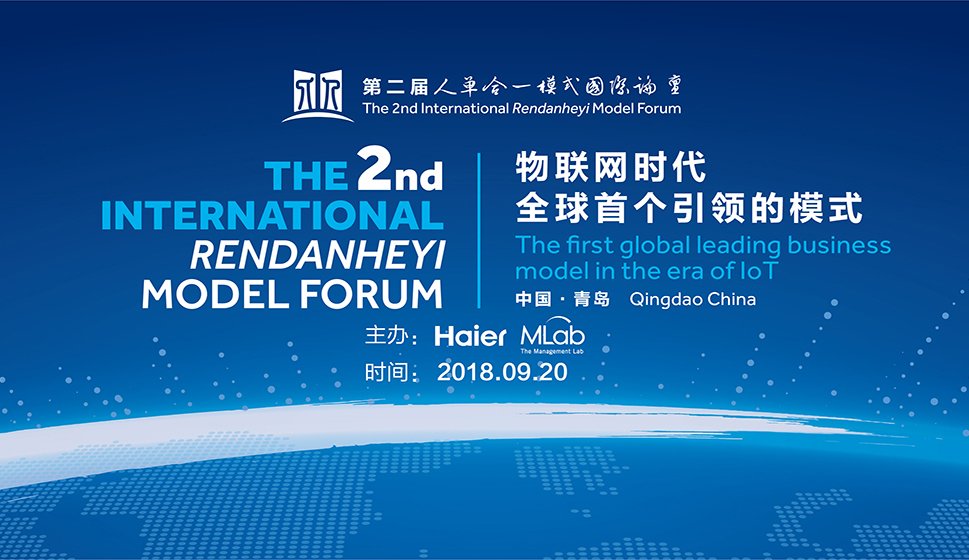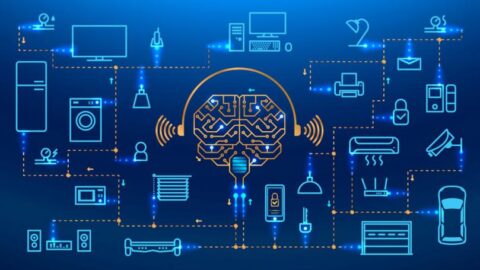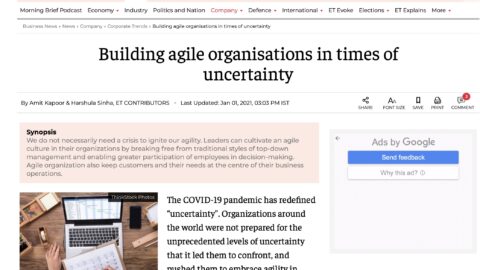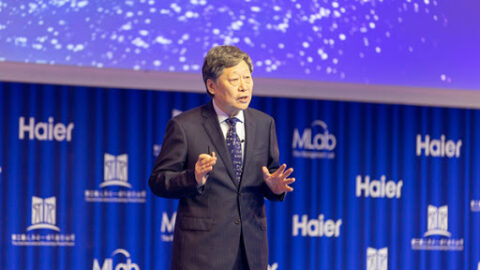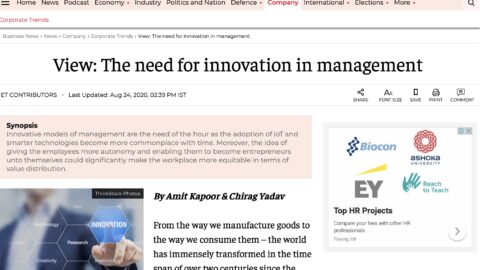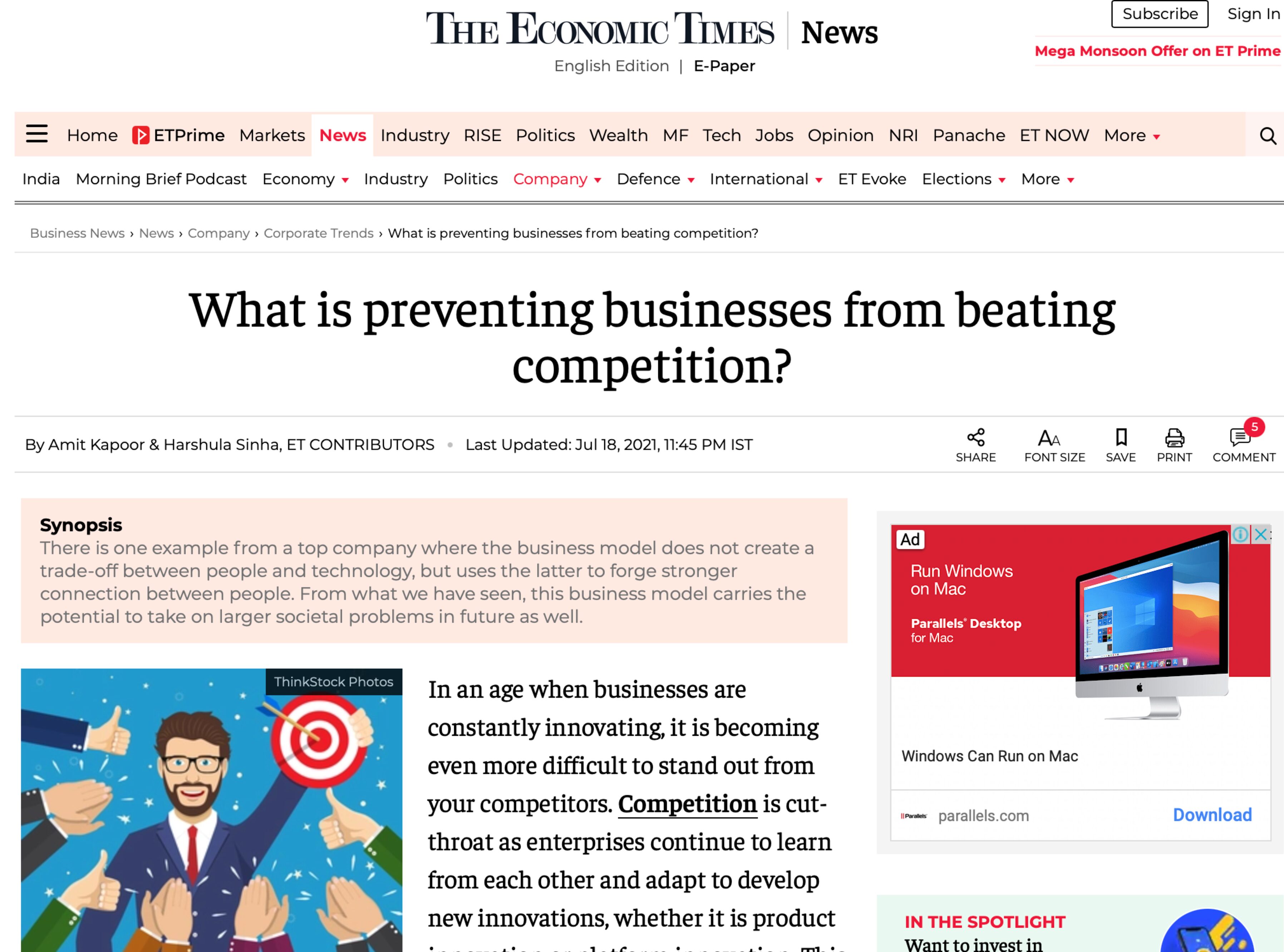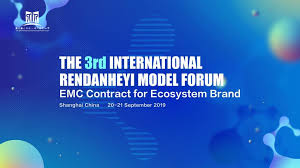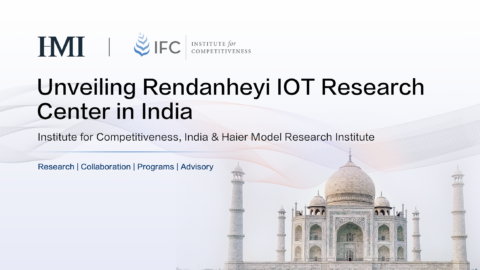3E: Ushering in a Transformative IoT Paradigm
Speech by Mr. Zhang Ruimin, Haier Group’s Chairman of the Board and CEO, at the 2nd International Rendanheyi Model Forum
We are gathering here today to seize the opportunity offered by IoT. The relationship between IoT and 3E is that of purpose and means. IoT will definitely see its explosive growth in 2019 or 2020 internationally, which is very soon. I intentionally chose to wear this tie that has mathematical equations drawn all over it. My hope is for all of us to solve these equations together so that Chinese companies can become the first ones to usher in the paradigm of IoT.
(Title) IoT is already redefining our era
The IoT paradigm is a product of our times. The First Industrial Revolution was powered by the steam engine, the second one was the internal combustion engine and electricity, the third was the Internet, and the fourth was the IoT. IoT was born in 1999, but people did not feel its existence back then. As Artificial Intelligence develops rapidly these years, people are increasingly feeling the presence of IoT.
The changes of times bring forth the changes of companies. During the first and second Industrial Revolution, companies were mostly linear and were faced with a unilateral market with one-on-one transactions. A transaction was deemed complete when a product made by a company found its customer and he or she paid for it. In the Internet era, the market is bilateral or multilateral, and there are platform companies such as in e-commerce.
This kind of change was accounted for by the 2014 Nobel Laureate Jean Tirole, who is from France. His bilateral or multilateral market addresses government and market failures, and opens the institutional black box that impedes market efficiency. Now all products are competing on e-commerce platforms so users have a plethora of choices, which is a very big change.
IoT turns companies into eco-organizations, ecosystems that generates iterations for user experiences. Traditional companies and even Internet companies are just doing transactions with customers, who are not yet users. If you want a certain product, nobody on the e-commerce platforms will tailor to your specific requirements. Like some economists said, your sense of satisfaction keeps
diminishing despite the fact you are being offered more and more options by e-commerce. In the IoT era, companies put users, or user experience to be precise, at the center, and become eco-organizations that dedicate to the iterations and upgrades of user experiences. Companies become ecosystems where the producer and consumer have become one.
This change was first observed by William Brian Arthur, who formulated the theory of Complexity Economics. He viewed the economy as an evolving and complex system. He believed classical economics was for the agricultural civilization, neoclassical economics was for the industrial civilization, and complexity economics was for the information civilization. The Internet and IoT are both complex systems.
A complex system is a self-adaptive network, constantly evolving and adapting with the times. At the same time, it is not linear, because user needs are not unified and linear, but rather personalized.
Against the changing times, Haier ignited IoT with 3E: ecosystem, ecosystem revenue and ecosystem brand. Ecosystem: both traditional firms and e-commerce players operate on transaction platforms; Haier instead is an ecosystem where communities interact with one another, which is unprecedented.
Ecosystem revenue: revenue should not only come from products, but also from services using products as a vehicle.
Ecosystem brand: be it traditional brands or platform brands, companies are the center, so it’s a zero-sum game; Haier is committed to creating brands through co-creation and coevolution.
Haier realized the changes of our times pretty early and came up with Rendanheyi on September 20, 2005, exactly 13 years ago. During this period, Haier has already done quite a few experiments. The 3E Haier used to ignite IoT is original, disruptive and leading-edge.
(Subtitle) The Originality of 3E
3E overcomes the limitation of the classical management theory.
I have talked about this with Mr. David Teece, who came up with the concept of
dynamic capabilities in 1994. He believes that the core competency of a company lies in its ability to renew its core competency. But what is a company’s core competency? In my opinion, it is its ability to create user value. And because user value and users’ needs keep changing, a company’s core competency has to keep changing as well. If you cannot keep up with the changes, then you will definitely be eliminated like Kodak and Nokia. David Teece’s dynamic capabilities refer to a company’s ability to adapt to and keep up with the times.
(Subtitle) Relevance in Today’s World
Haier disrupted itself to obtain dynamic capabilities. Specifically, we keep abreast with the times and are in complete sync with the community economy, sharing economy and experience economy that characterize IoT.
Let’s first look at the community economy. The ecosystem in Haier’s 3E corresponds to this concept. In the past, everything revolved around companies; in the Internet era, the focus is on e-commerce platforms; in the IoT era, communities are at the center of the stage. It is communities, rather than companies, that call the shots. Users with common hobbies and interests as well as personalized needs spontaneously form communities, which are the focus for experience iterations. If a company can satisfy their needs then it will be included, if not, it will be abandoned.
There are two things a company needs to do to be included into the communities: first is touch point network, which is neither retail stores nor e-commerce shops. It is not O2O either. Haier’s touch point network is O+3 as well as O+O, gathering all shops together. Haier went to rural China and interacted with the villagers and became a member of their community. We helped the villagers access drinkable water by installing water purifiers in their villages. In urban communities, Haier has established relationships with community residents via delivery cabinets.
Second is the wholeness of value, which is the biggest difference that sets Haier apart from traditional firms and e-commerce platforms. All companies do two things with value: they create it, then pass it on. Other companies create value before passing it on via e-commerce or chain stores. Haier has combined the two steps: we learn about users’ needs through community interactions and quickly generate products they need on the back end while constantly optimizing those products.
Let’s talk about the sharing economy, which is reflected through ecosystem revenue in Haier’s 3E. The sharing economy is about value created by all, and the added value is shared by all. In this way more experience value can be created. This is nothing like the so-called bike-sharing systems which are not sustainable as they do not provide any added value, nor are they really sharing. The basis for a sharing economy is ecosystem value add, meaning added value created by a comprehensive service solution using the product as a vehicle. At the same time it needs to be sustainable. Haier came up with the idea of a win-win value-adding statement. The US Institute of Management Accountants is currently working with us on this statement. Unlike the traditional income statement, where profits equal revenue deducted by costs, the win-win value-adding statement has included ecosystem revenue and service revenue aside from product revenue.
Now let’s look at the experience economy, which is a very important hallmark of IoT. And specifically in Haier’s 3E system, the equivalent is the ecosystem brand. What the experience economy is after is lifelong users, which means users who are satisfied with each experience we offer and so decide to stick with us for life. Many e-commerce players today often complain about how customers have no real loyalty in that they hop from one network to another in no time. Why is that? Because these e-commerce players do not offer satisfying user experience, much less constant iterations and satisfaction. So what did Haier do to keep its users satisfied? Mainly three changes: first, from cascade R&D to iterative R&D. On average, it takes companies one year to develop a new batch of products, but it only takes Haier three months or less to do the same as we constantly adjust to users’ changing needs; second, from traditional factories to interconnected factories; third, user experience has gone beyond being just about the product and become very comprehensive.
(Sub-subtitle) Case Studies
Shunguang’s ecosystem.
Foreign economists say we are moving from O2O to O+O, combining online with offline. Haier goes above and beyond by throwing social selling into the mix. The user experience is satisfied by a network of marketing, logistics, information and services. Shunguang is currently China’s biggest community economy network with over one million social sellers or micro shops.
Leader, the home appliance brand.
This is a home appliance brand that goes through iterations on the Internet. Leader used to be a pretty cheap brand, but its current positioning is being young and trendy. With constant interactions, iterations and development, it is hugely loved by young people. Leader has achieved a growth rate of 40% for seven consecutive quarters, which is very impressive. Its average unit price has jumped to over 12,000 Yuan from less than 2,000 Yuan. What’s worth noting is that we do not sell Leader in any physical chain stores, but only on the Internet, because interaction with our users is not possible at those chain stores.
Smaller wine bottles.
This idea sounds very simple. Back in July this year, a user told us that sometimes he could not finish a regular bottle of red wine and did not know what to do with the leftover wine, and he asked if it was possible to have smaller wine bottles. In August, a winery offered to develop such wine bottles. And in September, 100,000 bottles of wine in the new and smaller bottles were sold through VAM. Most interestingly, the idea originator, developer and all the other relevant parties had decided how to split the profits should the sales go beyond 100,000 bottles. The user who came up with the idea of smaller wine bottles had never thought he could be rewarded for his ideas. But this is exactly what sharing is about, all stakeholders can get what they deserve.
(Subtitle) The foundational platform for 3E: the Rendanheyi Model
First of all, the Rendanheyi Model has created the source for ecosystem value, meaning it allows 3E to create value continuously.
The Rendanheyi Model is all about the convergence of the value of employees and the added value for users. The value of employees is determined by the amount of user value they create. Because of this, the employees are motivated to do their best to realize user value. The ancient Greek philosopher Aristotle said, a man is most happy when he can use his creativity freely to realize his full potential. However, many modern companies normally cannot do this because of bureaucracy. There are many leaders within a company, and you have to do whatever they ask you to do. But under the Rendanheyi Model, Haier’s employees form start-ups where their leaders are the users, rather than people from within the company. The only goal is to maximize user value, and that’s why the employees’ creativity is always engaged. This naturally addresses the co-existence issue of value rationality and instrumental rationality as was raised in Max Weber’s The
Protestant Ethic and the Spirit of Capitalism. Max Weber believed that bureaucracy might be the best system back then, but he also saw that the greatest shortcoming of this system was that it suppressed people’s creativity. With the advent of assembly lines, everybody working in factories became an attachment or tool for the assembly lines, meaning there was only instrumental rationality, and value rationality was no where to be found. The Rendanheyi Model helps realize people’s value.
Secondarily, the Rendanheyi Model honors systematic thinking.
Bureaucracy breaks a company down to many individual departments. But under the Rendanheyi Model, a company becomes an integrated whole, and becomes interconnected with the users. I often talk with Professor Danah Zohar, the originator of quantum management, about how quantum management can help advance the Rendanheyi Model. She came up with the concept of the quantum self. What this means is that a person is both an independent self and an altruistic self that creates value for others. The thing is, it is very difficult to know how capable someone can become. Traditional companies only do four things with their employees: selecting, training, using and retaining, but the employees’ potential capabilities are usually neglected. Under the Rendanheyi Model, you have no idea how powerful a certain employee can get, so it’s better to create a platform where they can work on their own without your directions.
Systematic thinking is the biggest difference between Chinese culture and western culture. 2,500 years ago, Democritus formulated the atomic theory of the universe: all things are made up of atoms, the smallest unit of matter. Around the same time, Lao Tzu formulated his systems philosophy: the Tao follows the natural course of everything. What is Tao? It is nature, a system. Tao Te Ching said: the best way to carve is not to split, but split is what most companies do. So the Chinese culture actually provides fertile ground for quantum management to flourish. W. Edwards Deming came up with Total Quality Management (TQM), but it gained little traction in the US. But TQM became widely popular in Japan, which til this day still offers the Deming Prize. The Americans wanted to learn from the Japanese by going to Japan and taking pictures of every motion happening in Japanese factories, but they couldn’t achieve the same results even though they were trying to replicate everything the Japanese were doing. Why? Because their culture doesn’t support it: the Americans value individualism whereas the Japanese uphold collectivism. By the same token, quantum management has great potential in China which believes in systems philosophy whereas the western culture is
largely rooted in the atomic theory.
Thirdly, the Rendanheyi Model has overturned the classical management theory in two ways.
The first way is about organization. Haier has turned a bureaucratic organization into a networked one. We let go of 12,000 middle managers a few years ago, which caused huge reactions on the Internet because it was almost mission impossible. But looking back, we did what we had to do. The current Haier is a networked entrepreneurial platform, where “three selves” organizations can be set up: self-start-up, self-organized and self-driven. Self-start-up: Start-ups can be set up to tackle market’s hardest problems, which are our biggest opportunities. Self-organized: the entire world is my Human Resources Department. Self-driven: if there is venture capital, I will invest as well; if users want us, we keep going, if not, then the start-up has to go. So these organizations are entirely autonomous.
But in order to achieve “three selves”, the leader must delegate three things first: what decisions to make, what to pay, and whom to use. Many company leaders told me they can’t manage their employees properly if they let go of these three things. But why do you have to be in control of everything? Why can’t you let your employees become CEOs just like you? Peter Drucker said, in the 21st century everybody working in companies should be their own CEO. That’s why we say Haier doesn’t produce products, it produces entrepreneurs.
The 2009 Nobel laureates Elinor Ostrom and Oliver E. Williamson have dedicated their entire life to studying the third power of economic governance beyond the government and market, namely self-organization and self-governance. What is the power of the government? It is the visible hand we usually talk about. What is the market? The invisible hand. But self-organization and self-governance are more important, they are neither the invisible hand nor the visible hand. What are they? Self-evolving organizations. In the IoT era, external environments are very messy and change extremely rapidly, so self-evolution becomes very crucial, without it one won’t know where they are and where they should be headed.
The second way the Rendanheyi Model overturns the classical management theory is through remuneration.
Remuneration is a driving force for any organization, and Haier has changed
from pay by the company to pay by the users. Haier used to adopt the broad-banded salary structure from American companies. But the current pay is determined by the extent to which user needs are satisfied: more user value, more pay; no user value, no pay. In this way, Haier has transformed its employees from economic and social persons into autonomous persons who decide their own fate and pay.
On one afternoon in March this year, I went to Harvard University and chatted with Professor Oliver Hart. He received the Nobel Prize in 2016 for his theory of incomplete contracts. This theory is about the relationship between ownership and residual control right. The amount of ownership determines how much residual revenue gets allocated. According to his book Firms, Contracts and Financial Structure, even though golden handcuffs in the form of employee stock options have been created as an incentive mechanism, it still cannot address the mismatch between the ownership and residual revenue. What this means is that I can give my executives, which only account for 1% of the overall staff, 10% or 5% of stock options, but not everybody can get something like this, so the mismatch is still there. I told Mr. Hart that Rendanheyi can solve this issue. Because under this model, ownership is not allocated from the top, but created by the employees. You can have a start-up team within Haier, and if your start-up can create value and attract venture capital, people in the team can invest in the start-up as well, after which they will have ownership. As the start-up develops, its members can choose to invest more or less in it, and either way the ownership is created by theses employees rather than allocated from Haier. So this issue can be easily resolved.
Fourthly, the IoT paradigm under the Rendanheyi Model has realized two convergences. First, silos within a company have been eliminated, so the value created by employees has converged with the value created by users. In the past, companies had no idea who should take credit for creating user value, so the reward could not be properly allocated. But with the Rendanheyi Model things are much easier. The order will be delegated to a specific person or team from the very beginning, there will be sharing if value is created, accountability if not. Second is the convergence among industries after industry barriers are taken down and new experience value is co-created and shared. In the case of the small wine bottles, the wine cabinet supplier and winery whose industries had no prior relations decided to work together to co-create new experience value for the users, and the profits have been shared by all including the idea originator.
(Subtitle) The logical relationship of 3E: progressive optimization
The ecosystem is a necessary condition, while the ecosystem revenue is a sufficient condition. The Ecosystem brand is what the former two both point to.
The ecosystem is all about sensing and sharing. People say sensors abound these days, but the sensors I’m talking about here is not sensors on products, but rather sensors that can detect user emotions. The touch point network is capable of sensing user emotions and involving the users in the co-creation process, which is an important piece about the ecosystem.
Brands used to equal private labels. The Metcalfe’s Law is a very important law of the Internet, and according to it, the value of a network is proportional to the number of its nodes squared. People think e-commerce platforms have many nodes on them and thus follow the Metcalfe’s Law, but I think their so-called nodes are only customers, which are here today but gone tomorrow. Only those nodes that users stick to because they are constantly getting new experiences from us are real nodes, which are interconnected with everything else. And only these nodes have network value and the Metcalfe’s Law works extremely well on these nodes.
(Title) The disruptiveness of 3E.
Let’s approach this kind of disruptiveness using the Hegelian triad Thesis-Antithesis-Synthesis Model.
I am going to use the metaphor of a flower. The flower bud comes before the flower, which negates the former, and the fruit comes after the flower and negates the flower. The goal of this endless cycle of negation is to generate fruits. If a flower indulges in its own beauty, it will never bear any fruits. If the flower indulges in the fruits it bears, it will not have the next flower bud. The same goes for any company. So this is an never ending evolution.
We can also use the yin-yang symbol to understand this. The thesis is the starting point, united but with hidden opposites. A flower bud is a thesis, and a flower is hidden within it. The antithesis is the showing of the opposites. The synthesis is the unity of the two, meaning there is affirmation within negation, and that is the fruit. What comes after the fruit is another flower bud, so on and so forth.
(Subtitle) The disruptiveness of the ecosystem
Let’s look at how the Thesis-Antithesis-Synthesis Model has played out for the ecosystem. The thesis is workshop economy, which is a bit like community economy, albeit a very small one. The owner of a clothing shop or restaurant knows everybody in the neighborhood, and offers products that cater to everybody’s tastes and so are liked by all. So in a sense there is service revenue but it’s very limited. The antithesis is mass manufacturing. Clothes are no longer tailor made to fit your body. Instead, there are many sizes you have to choose from. E-commerce platforms offer many things but ignore personalized needs. The synthesis is community economy, which scales up the customization typical of the workshop economy so it becomes mass customization rather than mass manufacturing.
Internet companies do not actually have any users. Young Israeli scholar Yuval Noah Harari said in his book 21 Lessons for the 21st Century that we are not users to those data giants, we are their product. He said we are the products of the likes of Google and Facebook in that these companies allow us to use their sites for free so that they can acquire our data and run them through their algorithms to figure out how to control our buying behaviors. That’s why to these Internet companies, we are mere products and money-making tools rather than users. What the IoT sets out to do is to view people as users rather than customers or products, and to create user experiences.
(Subtitle) The disruptiveness of the ecosystem revenue
The same goes for the ecosystem revenue. Small workshops generate regional revenue with a shop at the front end and a factory at the back end and limited service revenue. But at the antithesis stage, this model no longer works because it can not have scale. So it evolves into a winner-takes-all model where product revenue comes from the global market. The synthesis is comprehensive ecosystem revenue, where marginal returns are increasing rather than diminishing.
In a traditional economy, marginal returns are bound to diminish over time. For instance, I produced 10,000 units and earned 10,000 Yuan in return. When I produce my next batch, the profit on each unit will definitely be less than 1 Yuan. Therefore, I will have to produce 12,000 or even 13,000 units in order to obtain the same profit of 10,000 Yuan. Even though my size is growing, my profit per unit is bound to decrease.
On the contrary, ecosystem revenue or service revenue can allow us to have increasing rather than diminishing marginal returns, and the key is a positive
feedback loop, which is also called self-reinforcing system. Haier’s added value plus sharing is such as system: everybody gets paid due to constant added value, so everybody is willing to make greater efforts to create even more added value, hence a real self-reinforcing system.
According to Stuart Crainer, “’Things diminish in value… whereas the value of users increases over time.’” Price wars are a must when you only go after the value of things, but the value of users increases over time. The value of users doesn’t increase automatically though, it only happens if you constantly create experiences for them. If you can’t do so or are not chosen by the users over time, then there won’t be any user value to speak of. Mr Crainer also said in his book that the success of a company is measured by the number of lifelong customers it has.
(Subtitle) The disruptiveness of the ecosystem brand
Now let’s look at the ecosystem brand using the Thesis-Antithesis-Synthesis Model. What do traditional brands rely on? Product premiums. Many international brands such as Nike and Adidas have very strong R&D capabilities and a global network, so ordinary companies can hardly rival them. These companies can sell their products at a premium, whereas their OEMs cannot.
The Internet era is all about platform brands, which generate premiums using traffic. The bigger the traffic, the higher the premiums. Before the Internet, you were either a brand company or an OEM working for different brands. In the Internet era, you either own a platform or are owned by one. Nowadays many people who would like to sell stuff have no other place to go to than e-commerce platforms. Despite large volumes of transactions, price wars are still unavoidable on these platforms.
But the IoT era is nothing like this, where the ecosystem brand is the key. Ecosystem brands cannot be created by companies themselves alone, but rather by coevolution. It takes three things to create an ecosystem brand in the IoT era: first, an ecosystem community, which is the basis for the coevolution; second, ecosystem revenue, which serves as the pathway; third, an ecosystem brand, which is the goal of the coevolution.
(Subtitle) Always be self critical
Hegel’s Thesis-Antithesis-Synthesis Model does not stop at synthesis. Due to its inherent conflicts, a synthesis can evolve into a new cycle of thesis-antithesis-synthesis, and it goes on and on.
This is very similar to what Lao Tzu said in Tao Te Ching: “All things carry Yin and embrace Yang, and blend their life breaths to produce harmony.” In other words, all things have yin and yang, which constantly fight with one another only to achieve an equilibrium or a synthesis in the end. In 1922, a Danish man named Niels Bohr was awarded the Nobel Prize in Physics. After he received the award, he used a yin-yang symbol and a motto in Latin contraria sunt complementa (opposites are complementary) to express his beliefs. Opposites don’t have to be adversarial. We are looking for a synthesis, which creates a higher goal.
Other companies might be conceited, but Haier’s culture is always about being self critical. We are constantly looking for our own issues and correcting the course using the Thesis-Antithesis-Synthesis Model.
(Title) 3E: Leading-edge
(Subtitle) Leading global standards setting
IEEE, ISO and IEC have all chosen Haier to lead the study and creation of international standards for both mass customization and industrial Internet platforms.
The reason why Haier beat its German, American and Japanese competitors in this regard is because Haier puts its users at the center, while the other companies usually put themselves at the center and do not really involve users. I told some German companies that they don’t have a KPI that we deem extremely important, and that is the percentage of products that get delivered directly to users’ homes without first having to be staged in a warehouse. This is possible because the users are involved in the process from the very get-go.
(Subtitle) Second is leading industry upgrades.
Haier is leading industry upgrades as well as global standards setting.
Under Haier’s Internet of Clothing (IoC), more than 2,000 players from the washing machine, detergent and apparel industries have all been interconnected.
This model merges users’ demand for the washing machine industry with that for other industries, thus creating a new need.
Many world renowned manufacturers from Germany and the US have joined IoC. IoC manages the entire life cycles of clothing and is experiencing very rapid growth as a result.
The starting point of Lejiachengpin under Haier’s RRS is oranges. Orange growers couldn’t raise their prices on e-commerce platforms so were not making much money; since they joined Lejiachengpin, their revenue has become 20 to 30 percent higher than when they were selling through e-commerce while the users can be sure of the quality of oranges as they have been given visibility into the whole growing process.
GE Appliances (GEA) has undergone significant changes since Haier’s acquisition in June of 2016 thanks to the Rendanheyi Model. The US home appliances industry declined by 1.1% from January through August this year, but GEA grew by 11% during the same period, which is unprecedented. The most important change was the overhaul of the previous linear management model, which was very complex with siloed departments. The Rendanheyi Model turned the departments into micro enterprises that face the market directly. And the pay system changed as the organization changed. The number of people getting rewarded grew from a handful to several hundred as now whoever has created user value will get rewarded.
I said to the employees of GEA, you Americans really pride yourselves on the first sentence in the second paragraph of the Declaration of Independence: all men are created equal. However, not all men are created equal in big American firms, where the CEO is the king or autocrat, and everybody else has to take orders from their superiors. Under the Rendanheyi Model, all people in the micro enterprises are their own decision makers and can prove their self-worth. Take the project FirstBuild, which centers around the users rather than the product. Even though this project took place in the middle of America and was about hardware, the development process was even more open than that of software development in the Silicon Valley, involving not only GEA employees but also college students and people from the community. This goes to show how innovative a community can get.
(Title) Conclusion
Lastly, I would like to end by quoting from James P. Carse’s Finite and Infinite Games, which was written over 30 years ago and now has multiple editions.
According to this book, there are only two types of games in this world, finite games and infinite games. The goal of a finite game is to win, whereas the goal of an infinite game is to continue playing. Infinite games do not have an end.
In the past, the goal of a company was to win, to become No.1 in the industry, to become an empire, but that’s not sustainable. Companies like these will not last. The goal of Haier’s 3E is to create user experiences which are changing constantly. So we are playing an infinite game, with the goal of forever continuing it. That’s why we need to be always pursuing user experiences and satisfying their needs.
This gives us a very good opportunity. Before, we were only following the classical western management theory, but today I hope Chinese companies can become management leaders in the world. Let’s grab this fabulous opportunity and never let go. Thank you.

